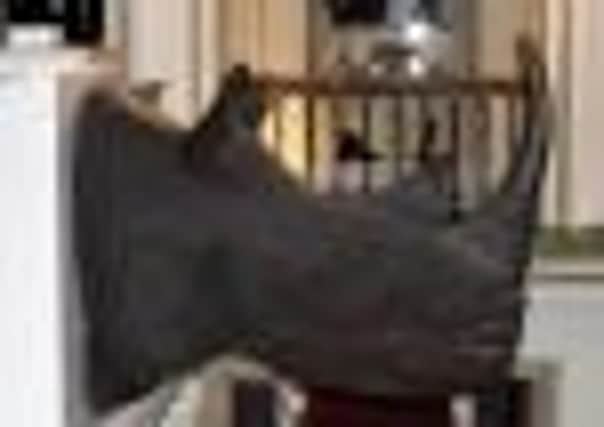Museum hides £400k rhino heads over robbery fears


The black and white rhino heads – two of the star exhibits at the Elgin Museum in Moray – have been transferred for safekeeping to the National Museums of Scotland in Edinburgh, following a spate of raids across Europe.
Rhino horns can sell for up £50,000 a kg on the black market – making them more valuable than gold or cocaine. Illegal powdered rhino horn is used in traditional Asian medicines and is prized as an aphrodisiac.
Advertisement
Hide AdAdvertisement
Hide AdIn February last year, a gang was foiled in a bid to steal a rhino horn from a display case at a Norfolk museum. In 2011, horns were stolen from three museums in France and a taxidermist in Vienna.


Janet Trythall, vice-president of the Moray Society, which owns the Elgin museum, said the rhino heads, which have been in its collection since 1941, had been transferred to the vaults of the National Museums to ensure the safety of museum staff. A late Ming dynasty rhino-horn cup has also been moved.
She said: “We were obviously concerned that someone might try and steal the rhino heads. There have been reports of many thefts of rhino material from museums over the past couple of years, on the continent and in England, often involving forced entry while the building has been occupied, and the use of CS gas spray.
“Many of these thefts have been violent thefts, and we had to think about the safety of our staff and volunteers. The horns are of sufficient value that people are prepared to take desperate measures to steal rhino horns.”
Advertisement
Hide AdAdvertisement
Hide AdMs Trythall said the society had been reluctant to surrender the “iconic objects” from its collection but had been left with no choice. “We tried to find alterative solutions,” she said. “We had installed a panic button at the door in the first instance, but after being contacted by a member of the staff from the cultural collections at the National Museums, we decided the exhibits just had to go.
“I think it’s unlikely the people of Moray will see these exhibits again in our lifetime.
“It’s awful to be dictated by these gangs as to what you are able to display, but we have to be realistic.”
The head of the white rhino had been on display in the museum’s main hall. It was shot in Sudan in 1913. The black rhino was shot in Northern Rhodesia. Both artefacts were donated by the father of Lieutenant Colonel Stuart Menzies, who lived at Arndilly House in Craigellachie.
Advertisement
Hide AdAdvertisement
Hide AdThe Chinese rhino horn was donated by George Boyd Anderson, a worldwide traveller and collector from Lossiemouth who died in 1972 and gave Elgin Museum nearly 100 objects he had collected during his travels.
A spokesman for the National Museums of Scotland described the transfer of the three exhibits to Edinburgh as a “one-off”, saying he wasn’t aware of any other museums taking the same step.
He added that all rhino material at the Edinburgh museums had been removed from public display some time ago. “Our exhibits are clearly marked up as ‘fake rhino horn’,” he said.
A spokesman for Glasgow Life, which runs many of the city’s museums, said it had removed a rhinoceros’ horn exhibit following a security assessment in August 2011.